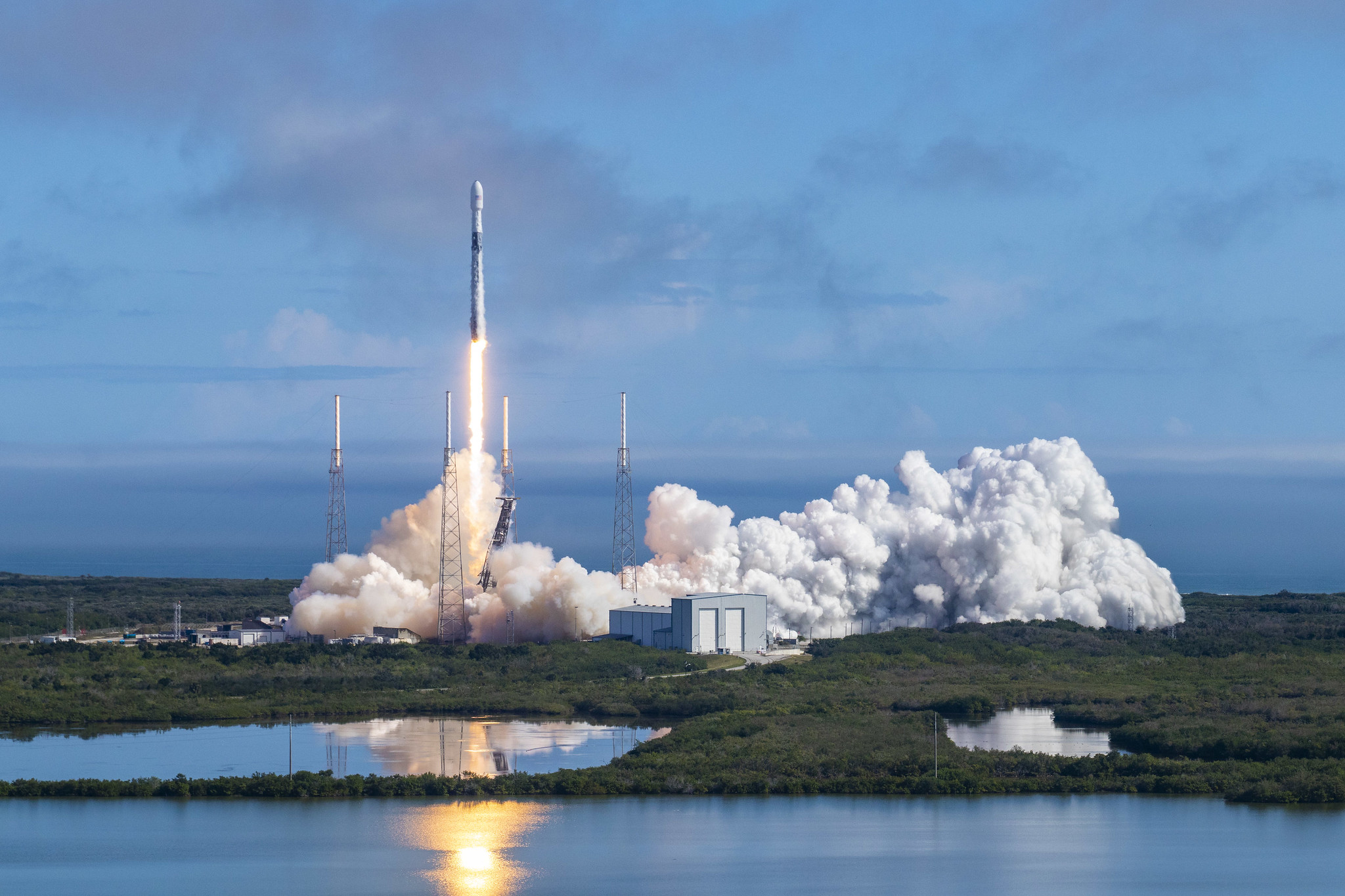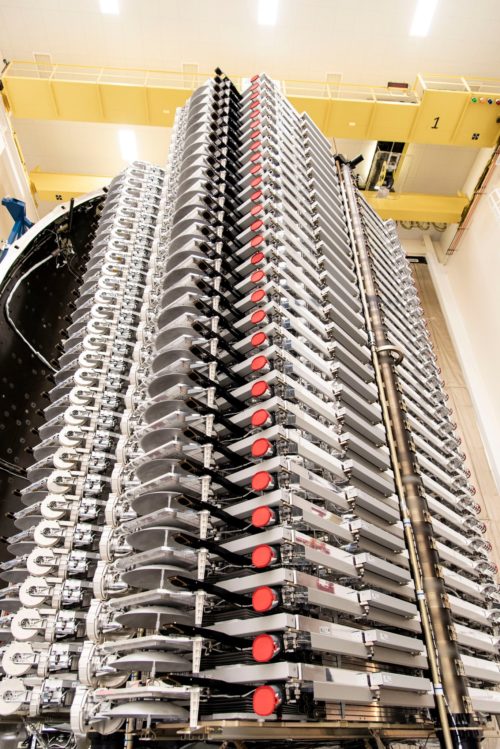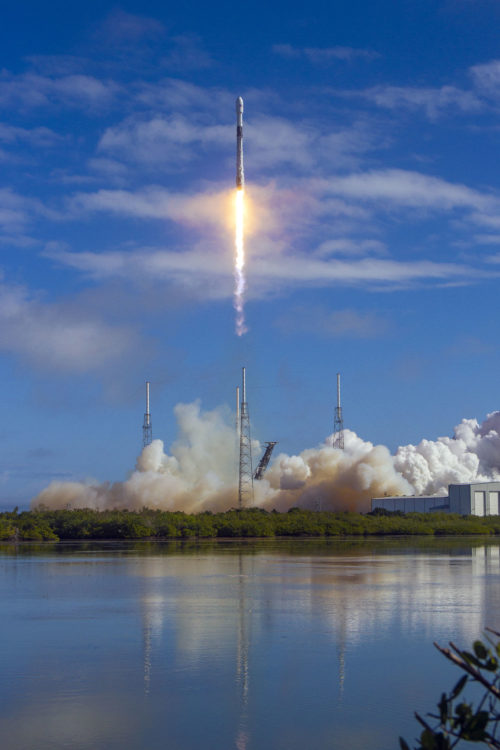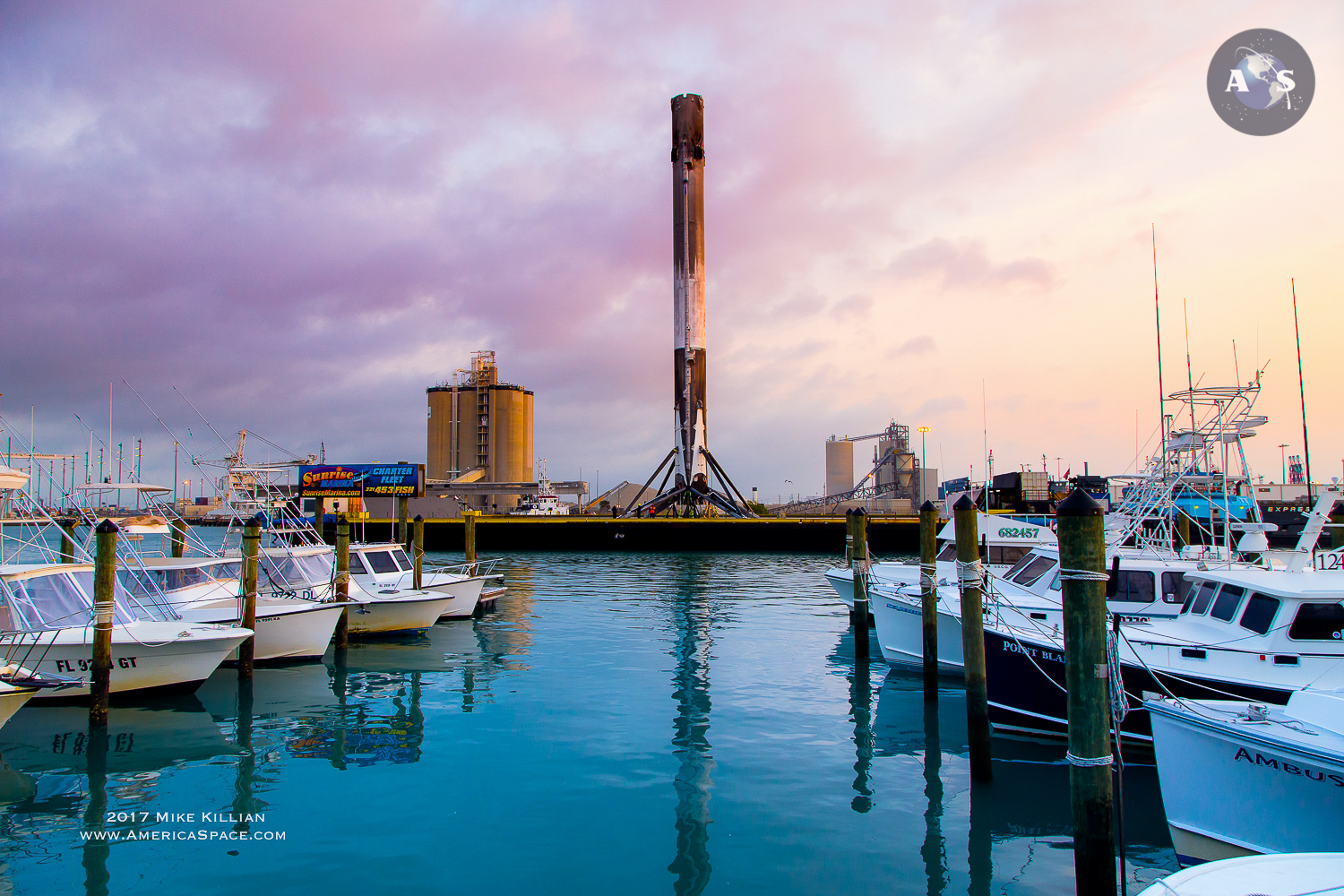
SpaceX successfully delivered another large batch of Starlink internet communications satellites to low-Earth orbit earlier today (Monday, 17 February) from Cape Canaveral Air Force Station, Fla. Liftoff of the fourth Falcon 9 of 2020—and the fourth booster core to fly a record-tying fourth mission—took place on time at 10:05 a.m. EST. However, it appeared that the core narrowly missed the deck of the Autonomous Spaceport Drone Ship (ASDS), “Of Course I Still Love You”, and instead impacted the ocean.
Having wowed the world in December 2015 when it triumphantly brought a Falcon 9 core to a bullseye touchdown on solid ground for the very first time, SpaceX has logged 31 offshore landings on Autonomous Spaceport Drone Ships (ASDS) on either the East or West Coasts of the United States and 18 “land” landings at either Cape Canaveral Air Force Station, Fla., or Vandenberg Air Force Base, Calif. It will be left to another mission to secure the milestone 50th landing.
Flying today’s mission was the Block 5 core tailnumbered “B1056”, which previously supported a pair of back-to-back Dragon cargo flights to the International Space Station (ISS) last summer—CRS-17 and CRS-18—before embarking on a high-energy launch towards Geostationary Transfer Orbit (GTO) to deliver the heavyweight JCSAT-18/Kacific-1 communications satellite shortly before Christmas. Launching again only 63 days later, today’s flight sets a new single-booster turnaround record for SpaceX as it eclipses the 72 days set by B1045 between its two missions in April and June of 2018. B1056 is also only the fourth Falcon 9 core in a matter of just three months to log a fourth flight.
As has become customary for Starlink launches, the payload is pre-integrated aboard the Falcon 9 stack. This allows for the pre-launch Static Fire Test of the nine Merlin 1D+ first-stage engines to be conducted with the payload in place and usually only a day or so prior to flight. The Starlink-4 Static Fire Test took place last Friday and its satisfactory completion enabled SpaceX to press ahead with their fourth launch in the first six weeks of 2020.

Hopes to fly on Saturday came to nothing, thanks to anticipated poor weather in the recovery zone, which threatened the satisfactory landing of B1056. And despite a 90-percent probability of acceptable weather conditions on Sunday, it was also scrubbed and moved 24 hours to Monday morning, due to the need to inspect a valve component on the Falcon 9’s second stage. The booster was lowered to a horizontal configuration on Saturday afternoon and a revised launch attempt was reset for 10:05 a.m. EST Monday, 17 February.
Weather conditions on Monday were highly favorable. “For the launch window Monday morning, skies will be mostly clear with a few cumulus clouds off the coast,” noted the 45th Weather Squadron at Patrick Air Force Base. “With low-level winds from the east, there is a very slight chance for cumulus clouds to move onshore during the window. Therefore, the primary concern for launch is the Cumulus Cloud Rule.”

Liftoff at 10:05 a.m. EST Monday occurred on time and within nine minutes B1056 had completed its re-entry burns and approached the deck of the ASDS, “Of Course I Still Love You”, some 390 miles (630 km) offshore in the Atlantic Ocean. However, in what would appear to be a classic case of “close, but no cigar”, the veteran core appeared to fall short of the ASDS and instead impacted the ocean. Meanwhile, the second stage’s Merlin 1D+ Vacuum engine commenced its customary six-minute “burn” to push the payload to its desired deployment altitude.
But here the commonalities with earlier Starlink missions ended. On previous flights, the payload typically deployed a little over an hour into the mission. However, on today’s flight, that process was expedited and the deployment got underway after only 15 minutes. “The Starlink satellites will deploy in an elliptical orbit approximately 15 minutes after liftoff,” explained SpaceX in its pre-launch press kit. “Prior to orbit raise, SpaceX engineers will conduct data reviews to ensure all Starlink satellites are operating as intended. Once the checkouts are complete, the satellites will then use their onboard ion thrusters to move into their intended orbits and operational altitude of 340 miles (550 km).”
Aside from the disappointing near-miss of today’s landing attempt, rocket reusability was always a central tenet of SpaceX CEO Elon Musk’s philosophy behind lowering the cost of getting hardware into space to eventually enable exploration as far afield as Mars. However, the process of actually bringing Falcon 9 cores back through Earth’s atmosphere at high re-entry velocities and temperatures and guiding them, via a system of hypersonic grid-fins, deployable landing legs and a fair amount of good fortune, to land softly either on an oceanic platform or solid ground was an enormous challenge. As Mr. Musk himself once remarked: “This is rocket science!”
First flown in June 2010, the earliest Falcon 9 cores were discarded after completing the initial boost of their payloads away from Earth. But with the maiden voyage of the upgraded Falcon 9 v1.1 vehicle in September 2013, a series of attempts were made to execute “controlled” oceanic landings of returning first stage hardware. This capability was made increasingly possible thanks to improved technologies for the “boost-back” of the core, as well as greater controllability in the descent phase. On this initial test, a controlled re-entry was achieved, but aerodynamic forces caused the core to begin rolling as it approached the ocean. The centrifugal effect starved its center engine of propellant and the core impacted the ocean hard. Seven months later, in April 2014, more powerful gaseous nitrogen thrusters helped to mitigate the aerodynamic rotation and resulted in a successful oceanic touchdown, whilst another attempt the following July saw the deployment of extendible landing legs to alight on the surface of the water. But the gremlins were not entirely done with SpaceX. The returning core from September 2014’s CRS-4 Dragon launch ran out of liquid oxygen, causing an uncontrolled ocean impact, but in February 2015—as a Falcon 9 wrapped up its mission to deliver NASA’s Deep Space Climate Observatory (DSCOVR) to space—a notable success was achieved in bringing the booster down within 33 feet (10 meters) of its intended point in the Atlantic.
Efforts to actually land on the Autonomous Spaceport Drone Ship (ASDS)—both the East Coast-based “Of Course I Still Love You” or the West Coast-based “Just Read the Instructions”—proved equally challenging for SpaceX. In January 2015, the grid-fin flight control surfaces prematurely exhausted their hydraulic fluid and the returning booster core experienced a hard impact with the ASDS. Another try in April reached the deck of the drone ship, but suffered excessive lateral velocity due to a stuck throttle valve and toppled over. The following December, a successful “land” landing was accomplished for the first time at Landing Zone (LZ)-1 at Cape Canaveral Air Force Station, Fla., but the problems of ASDS landings remained acute. A lockout collet on a landing leg put paid to a January 2016 attempt, whilst low fuel reserves following a high-energy Geostationary Transfer Orbit (GTO) launch in March also resulted in a hard landing. Success at sea was finally achieved in April 2016, when the returning booster core from the CRS-8 Dragon mission alighted onto the “Of Course I Still Love You” deck.

And although there have been ASDS and LZ-1 misses in recent years—one Falcon 9 core ran out of propellant just above the drone ship deck in June 2016, whilst the returning center boosters from two Falcon Heavy missions in February 2018 and June 2019 suffered exhaustion of TEA-TEB chemical igniter and a breached engine bay and Thrust Vector Control (TVC) failure—all told, the success rate has been high. Twenty-five returning Falcon cores have alighted on “Of Course I Still Love You” in the Atlantic Ocean, whilst six have done so on “Just Read the Instructions”, in the Pacific.
Added to this tally, 16 cores have landed on solid ground at LZ-1 at the Cape and two have done likewise on LZ-4 at Vandenberg. Four of those “land” landings were accomplished last summer alone. Only one booster intended to land on solid ground has failed; back in December 2018, a stalled hydraulic pump in the Falcon 9’s grid-fins induced controllability problems and the core landed out at sea.
.
.
FOLLOW AmericaSpace on Facebook and Twitter!
.
.




